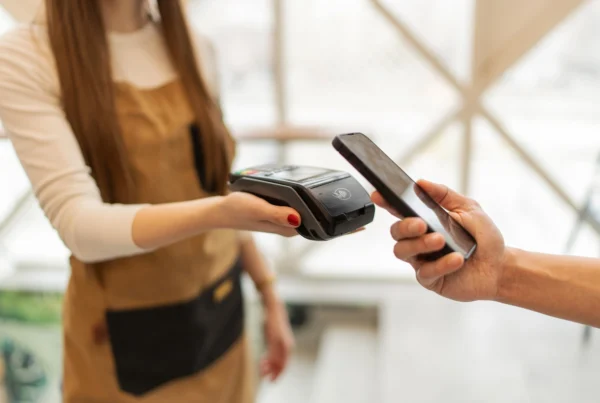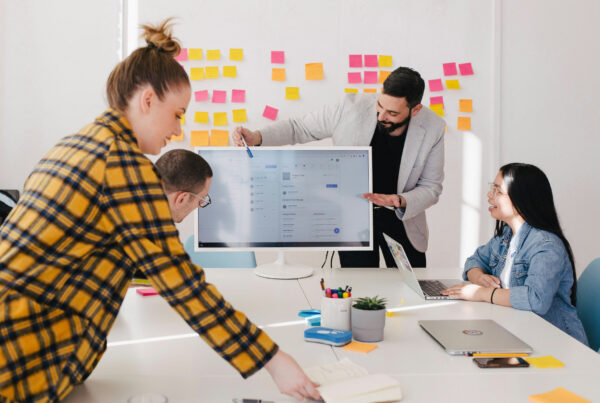SRM stands for supplier relationship management. It’s how companies handle relationships with their vendors, wholesalers, and manufacturers. Strong relationships with suppliers improve the service quality you receive, decrease costs, and streamline your procurement workflow. The relationships need to be beneficial to both you and your vendors to give you a long-term collaboration with greater stability, preferential treatment, and discount rates. In this article, we’ll walk you through what supplier management is, how it can benefit your business, its main components, and the 7 proven tips to manage suppliers successfully.
What is supplier relationship management (SRM)?

What is SRM?
Supplier relationship management (SRM) is the ongoing process of managing the work with vendors who supply materials, goods, or services to your company.
SRM is a systematic approach that collects and analyzes both quantitative data and qualitative supplier relationship-building skills. You evaluate each of those relationships, determine the critical vendors, and identify areas for improvement that are valuable to your business operations.
Through these assessments, you can find a strategy to improve vendor collaboration and bolster your supply chain. Effective SRM can help you achieve better prices, more trustworthy product quality, and more supportive services to answer your needs.
What are supplier relationship management examples?

Supplier relationship management examples
Different businesses have different types of suppliers. For example, suppose you’re a car manufacturer. You need an aluminum manufacturer to provide materials, a tire producer to supply finished tires, and a vendor supplying consumables for workers like gloves, coveralls, lubricants, etc.
On the other hand, if you’re a retailer selling apparel, your suppliers can be clothing wholesalers – from whom you’ll order completed products, or even material suppliers of fabrics, needles, sewing machines, and other equipment if you design and create your clothing items.
The relationships with those suppliers are important and usually handled by a procurement team to operate the company’s supply chain.
What are the benefits of vendor management?

Benefits of SRM
Since suppliers provide the materials and products essential to your organization, they play an important role in your business’s efficiency and bottom line. Having a strong SRM will return many benefits, such as:
Boost efficiency
Developing a deep relationship with suppliers helps you avoid miscommunication problems. You can build trust, facilitate better working conditions, and reduce disruptions and issues in your supply chain. Hence, you can enjoy higher efficiency and resolve problems faster if any.
Save more costs
Financial incentives are a significant factor in building relationships with vendors. The costs can be steep initially, but as you develop long-term relationships, you will be on the vendor’s priority list to acquire more offers. A sound SRM system helps you reduce problems and delays and gain more bargaining power to get the best price and quality.
Reduce price fluctuation
Prices in the commodity market can fluctuate a lot, such as during Covid-19, due to supply chain disruption. If you have close relationships with your vendors, you can deal with them to be less volatile in pricing. In addition, if you sign a long-term contract, vendors may be willing to offer a fixed price schedule, giving you a competitive advantage with the costs of goods sold.
What are the three basic components of supplier management?

Components of SRM
Managing relationships with suppliers involves the 3 main steps:
1. Supplier segmentation
First, segment your vendor list into 3 groups: strategic, tactical, and tail suppliers. Each group will require a different approach to SRM and resources to optimize the vendors’ performance.
- Strategic vendors: These are the critical vendors who bring the most value to your business. You may spend the most money with them, or get their innovation to create your products.
- Tactical suppliers: They are vendors that you purchase frequently but with a limited budget. You have many options for the same products and services within this segment.
- Tail vendors: This group contains additional suppliers who aren’t critical to your SRM process.
2. Develop a supplier strategy
The next step is devising a plan for how you’ll work with each category of suppliers to ensure successful and mutually beneficial relationships. Creating an SRM strategy will form and foster cooperation between your company and the vendors. It brings benefits for both parties, and thus, also supports your manufacturing to meet customer demand.
You should start with the segment of critical vendors to formulate an SRM plan focusing on quality and long-term collaboration. However, remember that all vendors play a role in your business success. Thus you should have strategic methods to work with the other 2 segments.
The better your relationships with suppliers, the more efficiency you’ll see in the procurement process, quality, and delivery speed. Furthermore, you may find inspiration to be more competitive over your competitors.
3. Execute the supplier strategy
The last component of an SRM is execution. When the strategy is put into action, make sure you have the plan to measure its progress and effects. Therefore, you can monitor day-to-day tasks on the SRM discipline and identify deficiencies and potential issues in the strategy or the execution.
Arrange regular examinations of your SRM as you interact with suppliers. Focus on KPIs like quality, performance, delivery, and service to improve your SRM plan. Share data and be straightforward about the expectations of your suppliers to guide them toward your objectives.
7 tips for managing supplier relationships effectively

Tips for managing supplier relationships
Managing vendor relationships involves a win-win partnership. Here’re 7 supplier relationship management best practices that you can apply for your business.
1. Choose suppliers with the same values
You’d want to develop intense relationships with suppliers who align with your core values. It’s essential to go in the long term together. Consider their business ethics, positioning, and reputation. Once you find a vendor with the same belief and values, nurture a relationship with them. It will benefit you with better quality products and customer services in the long run.
2. Treat your suppliers as partners
Remember that your suppliers are your partners, and you should build your relationships based on respect, trust, and loyalty. Keep an open mind and be willing to cooperate to resolve any issues.
Make sure your vendors feel your recognization for their contribution to your business. It’s a two-way relationship; thus, you should listen to their concerns and be fair with them. Be transparent about your processes, and respect their working methodologies. Support them when needed, such as by providing insurance certificates or proceeding with the necessary paperwork to collaborate.
3. Strong and detailed contract agreements
To avoid surprises during vendor execution, you must have a solid contract management process. Ensure you cover everything in the contract, as it will be the guideline to determine reliability when things go wrong.
Put down everything that parties expect from the partnerships as detailed as possible and signed by the authorized representative of both parties. The contract should include a product or service description, pricing, payment terms, delivery timeline, communication, and any liquidated damages or indemnity, depending on the complexity.
A detailed contract agreement will minimize confusion and disputes, as well as support your supplier risk management. Besides, you should explain the key points in the contract with your team, so everyone is clear on their responsibilities and easily follows the contract.
4. Invest in a supplier relationship management system

Supplier management software
SRM software allows you to track vendor performance, facilitate communication, and recognize potential problems. The tool is essential to manage supplier relationships more efficiently, especially if you purchase from multiple vendors with different minimum order quantities, lead times, and prices.
Retail management software like Magestore can help you boost your vendor relationship with various features:
- A central database to keep all supplier data, including name, contacts, product catalog or services provided, and previous contracts
- Contract management feature to create, sign, and store the contracts
- Tracking purchasing order status: View order status immediately, track the delivery speed, and get notified if an order is delayed
- Inventory management: View real-time inventory levels, alert low stock, and forecast demand to generate purchase orders for the vendors
- Supplier performance management: Evaluate vendor performance via scorecards to track their KPIs and monitor if they meet your expectations. In this way, you can identify the best and worst performers to provide suitable support.
- Accounting tools are integrated to create invoices, measure the cost of goods sold and manage cash flow.
5. Maintain regular communication
Honest, open, and frequent communication is vital to maintaining strong supplier relationships. Here’re some tips for an effective communication strategy:
- Keep the vendors updated regularly on your plans and actions so that they understand their position and work on your requirement and objectives
- Avoid setting unrealistic deadlines or changing your plans at the last minute. It’ll create stress and frustration for both sides.
- If any problems happen, act fast. Call the vendor immediately to discuss the issues. Being proactive will help you tackle small problems early before they become big ones.
- Let them know if you appreciate their work, or if anything should be changed. Feedback is essential to encourage your suppliers to continue their work with further improvement.
6. Make sure you pay on time
Cash flow is critical to any business; thus, punctual payment is necessary for your suppliers to stay with you. Paying your vendors on time is a way to show your respect and support to them. It proves that you’re a reliable client and easy to work with.
If there’re some reasons that you can’t release the payment timely, inform your partner as soon as possible and advise when they can expect the money or suggest a payment plan. Open communication on the reason will help your supplier understand and reduce frustration.
7. Reward good service with loyalty
If your supplier has performed well and shown outstanding customer support, reward them with loyalty. Although price is crucial in choosing a supplier, quality and support are the key factors to go in the long term. Therefore, don’t rush into any new supplier with lower prices, as they may not know your way of working and not offer the same support as your current supplier.
A healthy business relationship requires commitment from both parties and an understanding of how each party can bring value to the other.
In summary
Vendor management is a critical process for building long-term partnerships with your vendors. We hope with the above 7 tips, you can start mapping out your supplier relationship management strategy and nurture your supplier relationships – which creates a sustainable supply chain and increases your competitive advantage in the market.
FAQs
1. What are the three basic components of supplier relationship management?
There’re 3 main elements of supplier relationship management: supplier segmentation, supplier strategy development, and supplier strategy execution.
2. What are the functions of supplier relationship management?
SRM aims to create positive partnerships between you and the suppliers, as well as determine the strategy to engage with each vendor. It focuses on establishing and maintaining a mutually beneficial relationship with suppliers to promote efficiency, quality, innovation, and other benefits.













